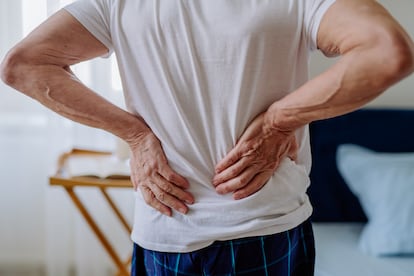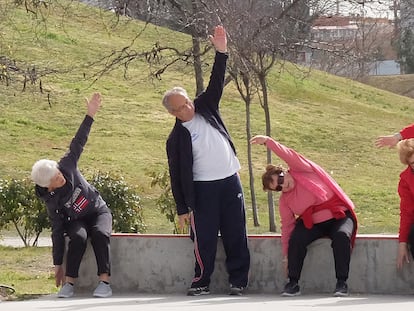More than 600 million people suffer from low back pain, the leading cause of disability in the world
A study estimates that the prevalence will increase by 36% in the next 30 years, and points to tobacco, awkward postures and obesity as the main risk factors

The back began to complain a long time ago. According to some scientists, the lament has been heard since the beginning of industrialization, which took us closer to modern life, but also brought some lifestyle changes such as a decrease in physical activity, poor postures and the use of furniture, a mix that led to a wedging in the bones of the lower back, which in turn brought the ache. Low back pain is one of the most frequent discomforts that make people seek out a doctor, and its evolution is on the rise: a study published in the journal The Lancet Rheumatology on the prevalence of this pathology states that more than 600 million people worldwide suffered from it in 2020, and estimates that, in 30 years, there will be more than 800 million affected. The authors point to smoking, awkward postures at work and obesity as key risk factors for this disease, which is already — and everything indicates that it will continue to be — the leading cause of disability.
Low back pain (also known as lumbago) is a somewhat intense discomfort in the lower back, “between the 12th ribs and the gluteal folds,” that lasts a day or more, as the study’s authors define. Marcos Paulino, president-elect of the Spanish Society of Rheumatology, who did not participate in the study, celebrates that what they are used to seeing in consultation is now presented with data in a scientific journal. “It is an epidemic, something very frequent. And it is a pathology that is difficult to prevent because, even if you recommend physical exercise, having a healthy weight and avoiding bad postures, 60% of all low back pain has no explanation. Only 40% is preventable.”
The doctor, who is also the head of the rheumatology service at the General University Hospital of Ciudad Real, Spain, says that the lower back is “the Achilles heel of the human being; an area that is very sensitive and which suffers more frequently.” He also points out that 80% of the population will have low back pain at some point in their lives. “The good thing about this study is that it quantifies it and can bring awareness to the magnitude of the problem,” he reflects.
In the systematic review published recently in The Lancet Rheumatology, the authors used data from the 2021 Global Burden of Disease study, a large, worldwide observational epidemiologic investigation on different pathologies, to estimate the prevalence of low back pain between 1990 and 2020 in more than 200 countries. The data shows that low back pain affected 619 million people in 2020; in 2050, there will be about 843 million. The highest age-standardized rates of prevalence were found in Central Europe, specifically in the Czech Republic and Hungary; the lowest were found in the Maldives and Myanmar.
According to Garland Culbreth, a researcher at the Institute for Health Metrics and Evaluation of the University of Washington and author of the study, the increase they foresee is due to trends in population growth and aging. “Population growth means more people, and population aging means more people in the most prevalent age groups; hence a rise in low back pain cases,” he notes.
Since this condition already was, according to the authors, the first cause of disability, the researchers also measured the years lived with disability (YLDs). This indicator reflects the impact of a disease on quality of life and estimates that one YLD is one full year of healthy life lost due to disability or poor health. In 2020, the authors note, there were 69 million YLDs due to low back pain, “and although there is a slight decrease from 1990 in the percentage of all-cause YLDs worldwide [...], low back pain was still the main contributor to YLDs globally,” they point out.
Scientists have confirmed that the global prevalence is higher in women than in men in all age groups, although the years weigh on the pathology: the prevalence of low back pain and the years lived with disability increase with age, being the age group of 80-84 years the one with the highest rate. In fact, one fifth of all older adults with low back pain report difficulties caring for themselves at home or participating in social and family activities.
Smoking, obesity and work
The authors point to smoking, obesity and occupational ergonomic factors as the main risk factors (although not the only ones) that cause low back pain. The risk of low back pain attributed to tobacco use was highest among middle-aged men and lowest among women ages 15-49, while the influence of work postures was strongest among young adult males (ages 15-49) and lowest in women over 70. The risk of low back pain from having a high body mass index (BMI) was highest in women ages 50-69.
Manuela Ferreira, a member of the Sydney Musculoskeletal Health group at the University of Sydney and author of the study, explains the role of tobacco: “Smoking has been associated with impaired circulation in spinal structures, such as the disc and joints, as well as with the weakening of the bones. But we also know that smoking is often associated with other lifestyle factors, such as physical inactivity, obesity, lack of sleep, all of which have been linked to an increased risk of developing low back pain.” The researcher also notes that a high BMI “could be linked to other unhealthy lifestyle factors that may increase the risk of low back pain, but it is also possible that a high BMI increases the load on the structures of the spine, predisposing them to injury.” Regarding occupational factors, Ferreira explains: “Occupational factors that can contribute to the risk of developing low back pain include lifting heavy objects, sitting or standing for a long time, bending and rotating the trunk repeatedly, as well as stress and fatigue.”
The researchers warn that the high prevalence of this disease throughout the world “could have some important social and economic consequences, especially considering the substantial cost of care for this condition.” They give an example: from 2012 to 2014, the direct costs for all individuals with a spine condition in the U.S. were $315 billion. Moreover, added to the economic weight of medical care for this pathology is the labor impact, as its high prevalence in the active population causes absences from work and even premature retirement. “In the U.S., 15.4% of the workforce reports an average of 10.5 lost workdays per year due to chronic low back pain,” states the study.
Ineffective drugs
The authors are wary of the potential effectiveness of some drugs, noting that “paradoxically, the use of treatments of no or little efficacy can delay recovery and potentially increase the risk of long-term back-related disability, and consequently increase the burden of this condition globally.” In that respect, Ferreira laments that “many treatments that are currently offered to manage low back pain have little, no, or unknown efficacy. They include simple pain relievers, such as acetaminophen, as well as strong ones such as opioids, physical therapies (traction, ultrasound, transcutaneous electrical nerve stimulation) and many surgical procedures such as surgical fusion. When these options are given to replace treatments that improve the symptoms of low back pain, such as exercise, psychological interventions and structured advice, they can delay recovery.”
Opioids for pain management, particularly, are in the spotlight: in Australia, for example, this type of drugs is the most prescribed medicine for low back pain. With the context of the very serious opioid epidemic sweeping the United States, researchers bring attention to the fact that opioids are “responsible for important adverse health events,” and warn against their use. “This strategy is harmful not only because opioids are associated with serious adverse effects, including death from overdose, but also, the benefits of opioids in improving pain and function in patients with low back pain are, at best, modest,” adds Ferreira.
Paulino admits that “time and resources” are needed to improve the response to this pathology. “In order to properly address the problem, to know the disease well, to exercise or to learn relaxation techniques to deal with the pain, time is needed. And we live in such a fast-paced society that the patient wants something quick, a pill, because they have to work or return to their activities. The approach would be better if we had more time and resources,” he reflects.
Sign up for our weekly newsletter to get more English-language news coverage from EL PAÍS USA Edition
Tu suscripción se está usando en otro dispositivo
¿Quieres añadir otro usuario a tu suscripción?
Si continúas leyendo en este dispositivo, no se podrá leer en el otro.
FlechaTu suscripción se está usando en otro dispositivo y solo puedes acceder a EL PAÍS desde un dispositivo a la vez.
Si quieres compartir tu cuenta, cambia tu suscripción a la modalidad Premium, así podrás añadir otro usuario. Cada uno accederá con su propia cuenta de email, lo que os permitirá personalizar vuestra experiencia en EL PAÍS.
¿Tienes una suscripción de empresa? Accede aquí para contratar más cuentas.
En el caso de no saber quién está usando tu cuenta, te recomendamos cambiar tu contraseña aquí.
Si decides continuar compartiendo tu cuenta, este mensaje se mostrará en tu dispositivo y en el de la otra persona que está usando tu cuenta de forma indefinida, afectando a tu experiencia de lectura. Puedes consultar aquí los términos y condiciones de la suscripción digital.
More information
Últimas noticias
Welcome to the post-religion era: The idea of Christianity as the absolute truth has become obsolete
‘I thought you would like it’: The risky sexual practice popularized by TV shows and TikTok
The digitalization of tourism: ‘They promise experiences and gave us the worst possible one’
Mexican peso defies uncertainty with forecasts of a new period of stability in 2026
Most viewed
- Sinaloa Cartel war is taking its toll on Los Chapitos
- Oona Chaplin: ‘I told James Cameron that I was living in a treehouse and starting a permaculture project with a friend’
- Reinhard Genzel, Nobel laureate in physics: ‘One-minute videos will never give you the truth’
- Why the price of coffee has skyrocketed: from Brazilian plantations to specialty coffee houses
- Silver prices are going crazy: This is what’s fueling the rally










































